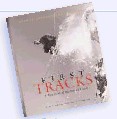
First Tracks:
A Century of Skiing in Utah,
by Alan K. Engen BS'63 BFA'63 and Gregory C. Thompson MA'71
PhD'81,  traces
the history of skiing in Utah, beginning with its early inception in the
late 1880s when miners in Alta and Park City devised skis made of barrel
staves to get around in snowy conditions. It didn't take long for skiing
to catch on as a popular form of recreation and competition—first
among the miners, then among the sports enthusiasts, who eventually flocked
to Utah's Wasatch Mountains to frolic in "the best snow on earth."
The book is illustrated with 435 vintage photographs and images (2001;
Gibbs Smith Publisher, Layton, Utah 84041; hardback, $50.00).
traces
the history of skiing in Utah, beginning with its early inception in the
late 1880s when miners in Alta and Park City devised skis made of barrel
staves to get around in snowy conditions. It didn't take long for skiing
to catch on as a popular form of recreation and competition—first
among the miners, then among the sports enthusiasts, who eventually flocked
to Utah's Wasatch Mountains to frolic in "the best snow on earth."
The book is illustrated with 435 vintage photographs and images (2001;
Gibbs Smith Publisher, Layton, Utah 84041; hardback, $50.00).
Engen is chair and president of the Alf Engen Ski Museum Foundation, chair and president of the Alta Historical Society, board member of the International Skiing History Association, and charter advisory member of the University of Utah Marriott Library's Utah Ski Archives. Currently, he is the director of skiing at Alta, Utah, and has been affiliated with the Professional Ski Instructors of America (PSIA) for more than 40 years. Thompson is assistant director for special collections, J. Willard Marriott Library, University of Utah, as well as an adjunct assistant professor of history. In the 1980s, he cofounded the Marriott Library's Utah Ski Archives Program. He is also a member of the Alf Engen Ski Museum Foundation Board.
In April 2001,
Engen received the Ullr Award (named after the Scandinavian patron
saint of skiing) from the International Skiing History Association for
his book, For the Love of Skiing: A Visual History.  Seen
through the eyes of his father, Alf Engen, who once coached the Olympic
Ski Team, the book provides a historical overview of U.S. ski sports,
from "its baggy-pants founding through the 2002 Olympic Winter Games
and beyond." Illustrated with more than 150 vintage photographs from
private and public collections, the book includes tidbits and little-known
facts that combine to create a fascinating historical collection ranging
from early ski-technology innovations and their inventors to biographies
of skiing greats who populated the sport and brought it to prominence.
Along with a historical review of the major competitions across the United
States from the 1930s to the present, For the Love of Skiing contains
personal accounts of wild and woolly ski adventures in the early days
of the sport. World champion Alf and his brother, Sverre, recall a "barnstorming,"
summer ski jumping competition in Omaha, Nebraska, where straw and soap
were used on the track to make it slick, and skiers were brought to a
halt by bumping into a bale of hay. Stopping was dangerous and injuries
were not infrequent. "I broke my toe trying to stop," Sverre
recounts, "and that toe still hurts…to this day" (1998;
Gibbs Smith Publisher, Layton, Utah 84041; hardback, $29.95).
Seen
through the eyes of his father, Alf Engen, who once coached the Olympic
Ski Team, the book provides a historical overview of U.S. ski sports,
from "its baggy-pants founding through the 2002 Olympic Winter Games
and beyond." Illustrated with more than 150 vintage photographs from
private and public collections, the book includes tidbits and little-known
facts that combine to create a fascinating historical collection ranging
from early ski-technology innovations and their inventors to biographies
of skiing greats who populated the sport and brought it to prominence.
Along with a historical review of the major competitions across the United
States from the 1930s to the present, For the Love of Skiing contains
personal accounts of wild and woolly ski adventures in the early days
of the sport. World champion Alf and his brother, Sverre, recall a "barnstorming,"
summer ski jumping competition in Omaha, Nebraska, where straw and soap
were used on the track to make it slick, and skiers were brought to a
halt by bumping into a bale of hay. Stopping was dangerous and injuries
were not infrequent. "I broke my toe trying to stop," Sverre
recounts, "and that toe still hurts…to this day" (1998;
Gibbs Smith Publisher, Layton, Utah 84041; hardback, $29.95).
In Endless
Winter: An Olympian's Journal, cross-country skier Luke Bodensteiner
BA'94 records the year he spent preparing for the 1994 Olympic Winter
Games in Lillehammer, Norway.  The
journal reveals the rigors of training for an endurance sport and the
commitment required to become a champion. Bodensteiner's daily jottings
reflect the gamut of emotions felt and adventures experienced during one
remarkable year in the life of an athlete (1994; Alta Press, West Bend,
Wisconsin 53090; paperback). Originally from West Bend, Wisconsin, Bodensteiner
is a two-time NCAA champion and the 1994 national champion. He is also
twice an Olympian who finished first on the U.S. team in the 30-kilometer
races in the 1992 Olympic Winter Games in Albertville, France, and in
Lillehammer.
The
journal reveals the rigors of training for an endurance sport and the
commitment required to become a champion. Bodensteiner's daily jottings
reflect the gamut of emotions felt and adventures experienced during one
remarkable year in the life of an athlete (1994; Alta Press, West Bend,
Wisconsin 53090; paperback). Originally from West Bend, Wisconsin, Bodensteiner
is a two-time NCAA champion and the 1994 national champion. He is also
twice an Olympian who finished first on the U.S. team in the 30-kilometer
races in the 1992 Olympic Winter Games in Albertville, France, and in
Lillehammer.